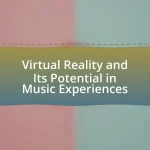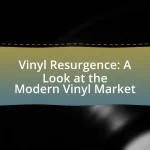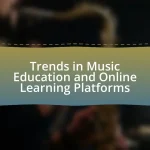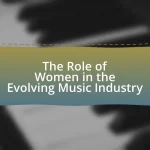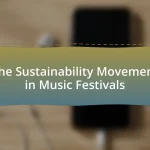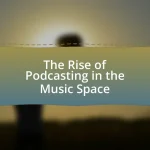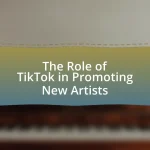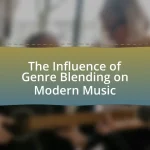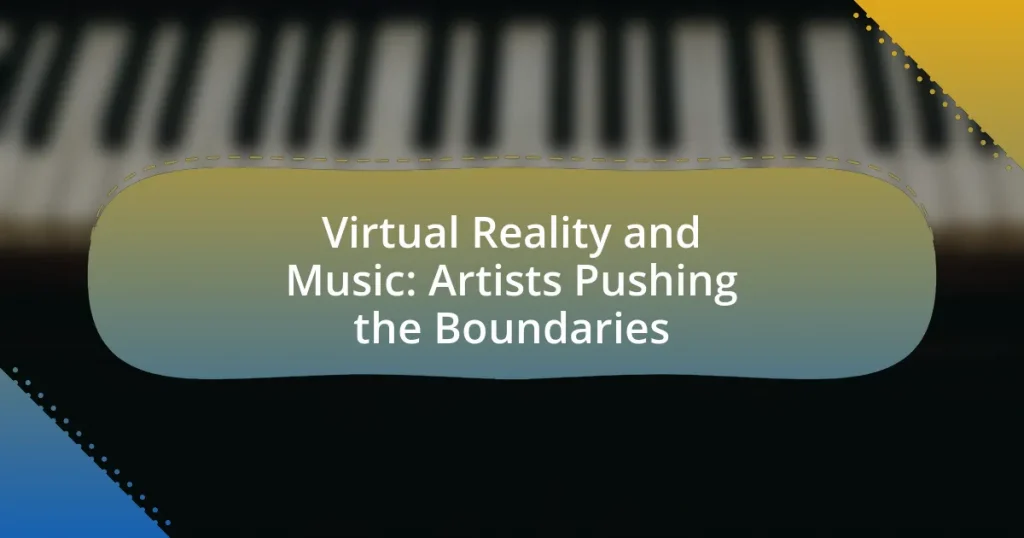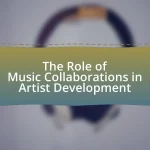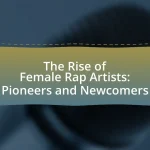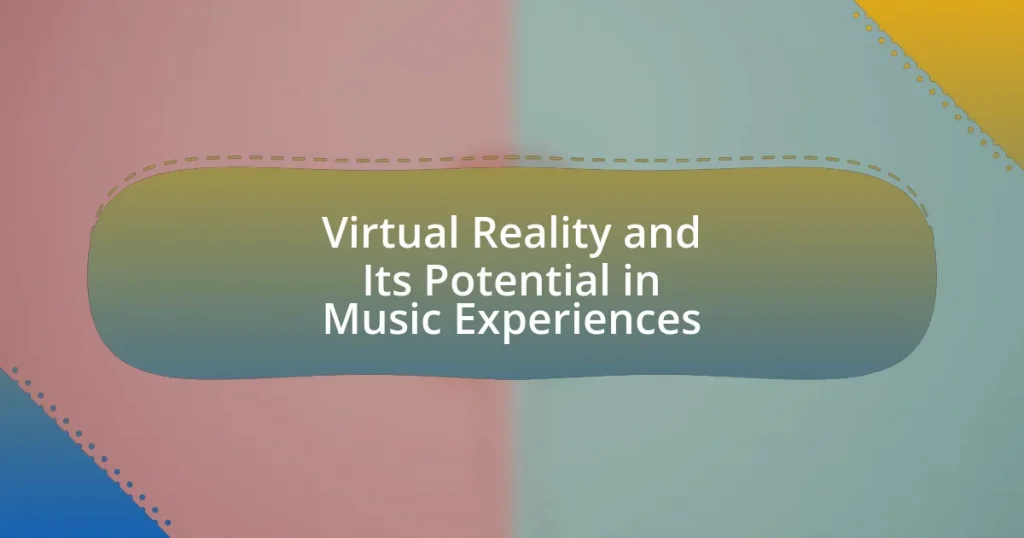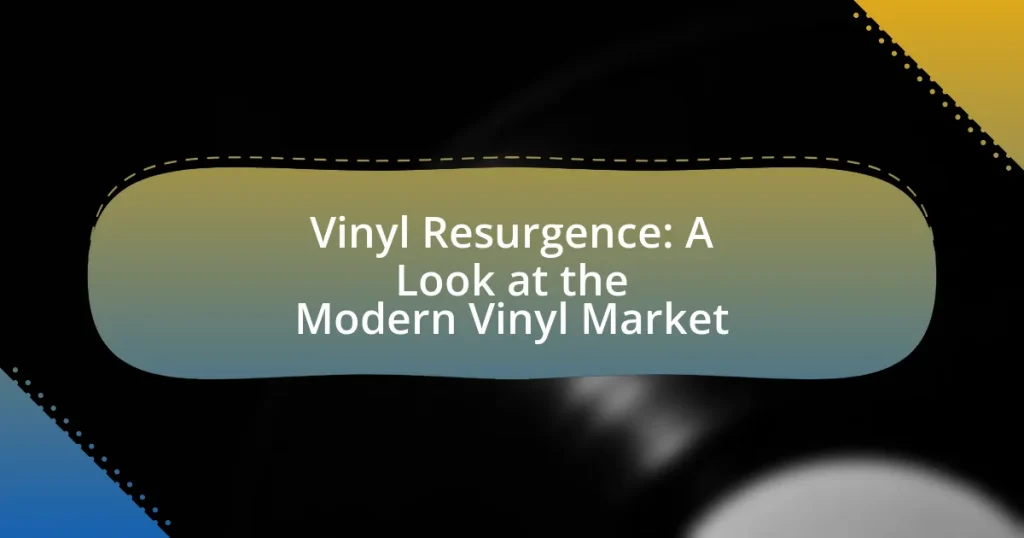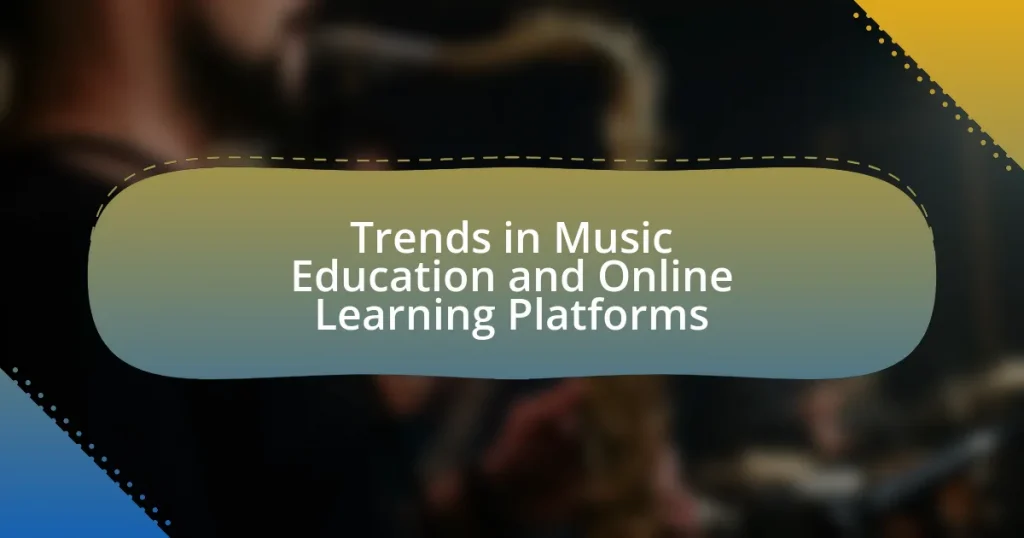The article explores the intersection of Virtual Reality (VR) and music, highlighting how VR enhances musical experiences through immersive environments that allow for innovative interaction with sound. It discusses the transformative impact of VR on live performances, enabling artists to create virtual concerts and interactive music videos that engage audiences emotionally and spatially. Key artists, such as Björk and The Weeknd, are examined for their pioneering use of VR in music, alongside notable projects that showcase the potential of this technology. The article also addresses the challenges artists face in integrating VR, including production costs and technical limitations, while predicting future trends that will shape audience engagement and artistic expression in the music industry.
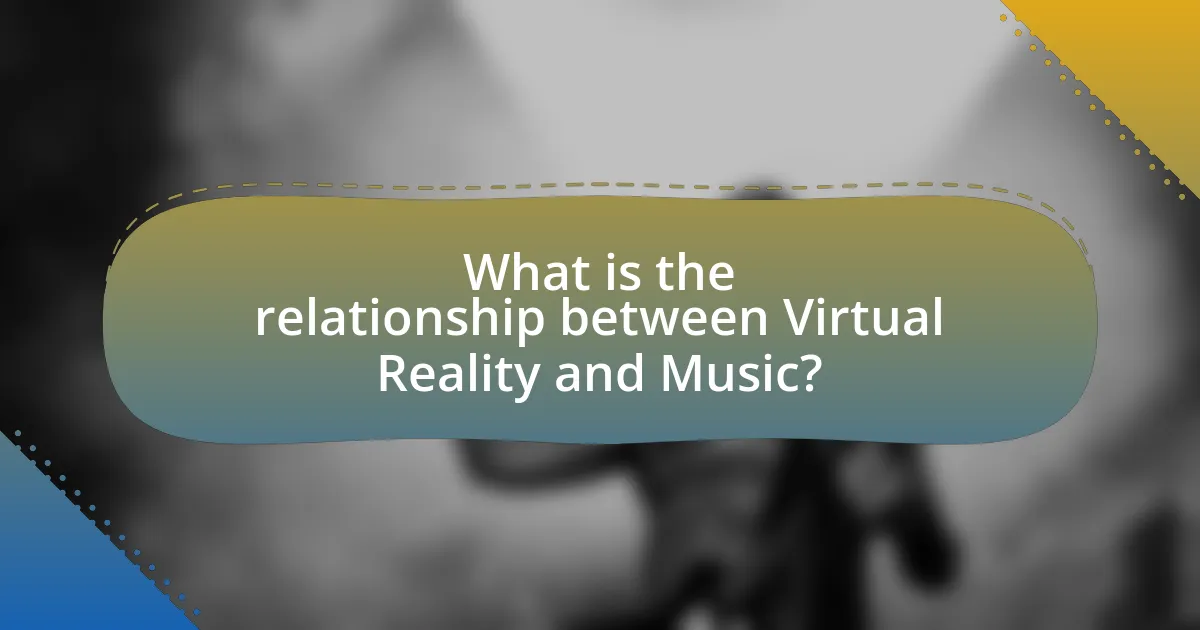
What is the relationship between Virtual Reality and Music?
The relationship between Virtual Reality and Music is that Virtual Reality enhances musical experiences by creating immersive environments where users can interact with sound in innovative ways. This technology allows artists to design virtual concerts and interactive music videos, enabling audiences to engage with music spatially and emotionally. For instance, platforms like Oculus Venues and VRChat host live performances where users can experience music in a 360-degree space, transforming traditional concert formats. Additionally, studies have shown that immersive audio-visual experiences can increase emotional responses to music, making the integration of VR and music a powerful tool for artists to push creative boundaries.
How is Virtual Reality transforming the music experience?
Virtual Reality is transforming the music experience by creating immersive environments where users can engage with music in interactive ways. This technology allows listeners to attend virtual concerts, explore 3D soundscapes, and interact with artists and other fans in real-time. For instance, platforms like Oculus Venues and Wave XR have hosted virtual concerts that simulate the atmosphere of live performances, enabling fans to experience music in a more engaging and participatory manner. Additionally, studies indicate that VR can enhance emotional responses to music, as users feel more connected to the performance and the artist, thereby enriching their overall experience.
What immersive elements does Virtual Reality add to music performances?
Virtual Reality adds immersive elements to music performances by creating a three-dimensional environment where audiences can interact with the music and visuals in real-time. This technology allows for spatial audio experiences, enabling listeners to perceive sound from different directions, enhancing the overall auditory experience. Additionally, VR can incorporate visual elements such as dynamic stage designs and interactive avatars, allowing users to feel as if they are part of the performance. For instance, artists like Björk have utilized VR to create fully immersive music videos that engage viewers on multiple sensory levels, demonstrating the potential of VR to transform traditional music experiences into interactive, participatory events.
How do artists utilize Virtual Reality to enhance their music?
Artists utilize Virtual Reality (VR) to enhance their music by creating immersive experiences that engage audiences on a deeper emotional level. Through VR, musicians can design virtual environments that complement their soundscapes, allowing listeners to experience music in a multi-dimensional space. For instance, artists like Björk and The Weeknd have released VR experiences that combine visuals and sound, transforming traditional music consumption into an interactive journey. This approach not only captivates audiences but also expands the creative possibilities for storytelling within music, as evidenced by the increasing number of VR concerts and music videos that have emerged in recent years.
Why are artists exploring Virtual Reality in their music?
Artists are exploring Virtual Reality in their music to create immersive experiences that engage audiences on a deeper emotional level. This technology allows musicians to transcend traditional performance boundaries, offering interactive environments where listeners can participate in the artistic process. For instance, VR enables artists to visualize their music in three-dimensional spaces, enhancing the sensory experience and fostering a unique connection with fans. The rise of platforms like Oculus and HTC Vive has facilitated this exploration, as they provide tools for artists to experiment with new forms of storytelling and expression, ultimately redefining how music is experienced.
What creative opportunities does Virtual Reality provide for musicians?
Virtual Reality provides musicians with immersive environments for live performances, enabling them to engage audiences in novel ways. By utilizing VR technology, artists can create interactive concerts where viewers experience music in a 360-degree space, enhancing emotional connection and engagement. For instance, platforms like Oculus Venues allow musicians to perform live in virtual settings, reaching global audiences without geographical limitations. Additionally, VR enables musicians to experiment with visual storytelling, integrating music with dynamic visuals that respond to sound, thus expanding the creative possibilities of their art.
How does Virtual Reality allow for new forms of artistic expression?
Virtual Reality (VR) enables new forms of artistic expression by immersing artists and audiences in interactive, three-dimensional environments that transcend traditional media. This immersive experience allows creators to manipulate space, sound, and visuals in ways that were previously impossible, fostering innovative storytelling and engagement. For instance, VR art installations can create a sense of presence and agency, allowing viewers to explore and interact with the artwork, thus transforming passive observation into active participation. Additionally, VR facilitates collaboration among artists across different disciplines, as seen in projects that combine music, visual art, and performance, leading to unique, multi-sensory experiences. The integration of real-time feedback and user interaction in VR also allows artists to adapt their work dynamically, enhancing the emotional impact and personal connection with the audience.
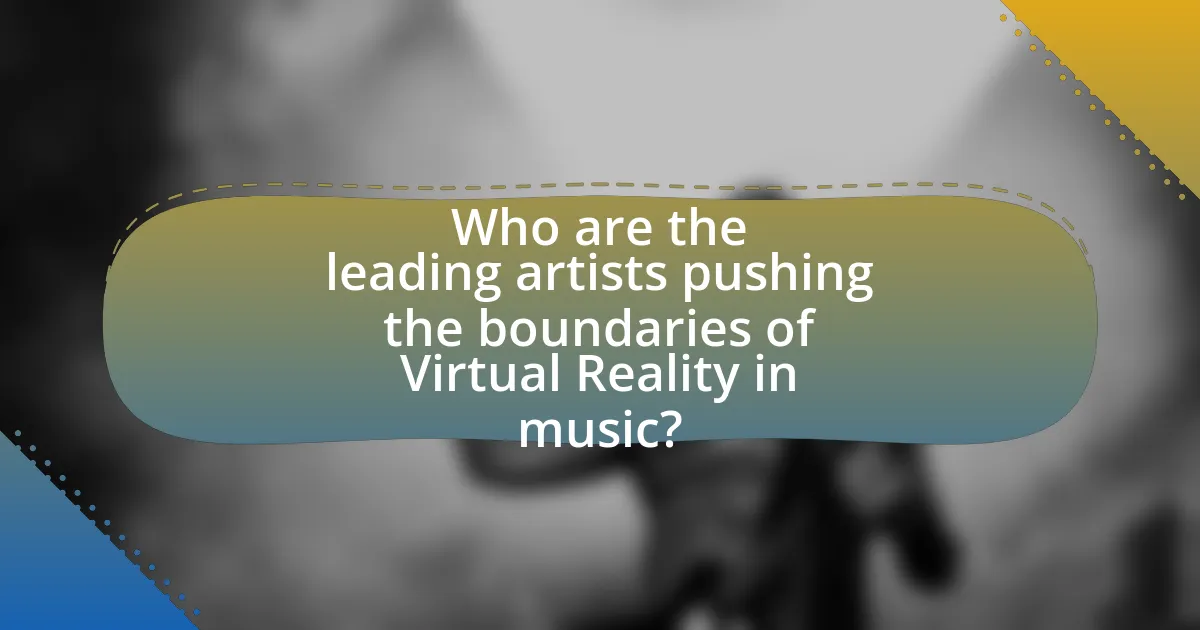
Who are the leading artists pushing the boundaries of Virtual Reality in music?
The leading artists pushing the boundaries of Virtual Reality in music include Björk, who has integrated VR into her performances and music videos, and The Weeknd, known for his immersive VR experiences during concerts. Additionally, artists like Travis Scott have utilized platforms like Fortnite to create virtual concerts that blend gaming and music, showcasing the potential of VR in live performances. These artists exemplify innovation in the music industry by leveraging VR technology to enhance audience engagement and create unique experiences.
What notable projects have artists created using Virtual Reality?
Notable projects created by artists using Virtual Reality include “The Night Cafe” by creator K. J. McElrath, which immerses users in a 3D recreation of Vincent van Gogh’s famous painting, allowing exploration of the environment. Another significant project is “Tree” by artist and designer, David OReilly, which offers an interactive experience where users can grow and explore a virtual tree. Additionally, “The Infinite” by artist and musician, Jonny Greenwood, combines music and visual art in a VR space that evolves with the user’s movements. These projects exemplify how artists leverage Virtual Reality to create immersive experiences that blend visual art and music, pushing the boundaries of traditional artistic expression.
How have these projects changed the landscape of live music?
Virtual reality projects have transformed the landscape of live music by creating immersive experiences that engage audiences in unprecedented ways. These projects allow artists to perform in virtual environments, enabling fans to attend concerts from anywhere in the world, thus expanding access to live performances. For instance, platforms like Oculus Venues and Wave have hosted virtual concerts that attracted thousands of viewers simultaneously, demonstrating a shift from traditional venue limitations to a global audience reach. This evolution not only enhances fan engagement but also opens new revenue streams for artists through virtual ticket sales and merchandise.
What collaborations between artists and VR developers have emerged?
Collaborations between artists and VR developers have emerged prominently in projects like “The Night Cafe,” where artist Vincent Morisset partnered with VR developers to create an immersive experience based on Vincent van Gogh’s artwork. Additionally, the collaboration between musician Björk and VR developers resulted in the “Björk Digital” project, which combines her music with interactive VR environments. These partnerships illustrate how artists leverage VR technology to enhance their creative expressions and engage audiences in novel ways.
Which genres of music are most influenced by Virtual Reality?
Electronic music genres, particularly EDM (Electronic Dance Music), ambient, and experimental music, are most influenced by Virtual Reality. These genres leverage VR technology to create immersive experiences that enhance soundscapes and engage listeners in novel ways. For instance, artists like Deadmau5 and Björk have utilized VR to produce interactive music videos and live performances, showcasing how VR can transform the auditory experience into a multi-sensory journey. The integration of VR in these genres allows for innovative storytelling and audience interaction, solidifying their influence in the evolving landscape of music.
How does Virtual Reality impact electronic music performances?
Virtual Reality significantly enhances electronic music performances by creating immersive environments that engage audiences in novel ways. This technology allows artists to design virtual spaces where visual elements synchronize with music, offering a multi-sensory experience that traditional performances cannot replicate. For instance, platforms like Oculus Venues have hosted virtual concerts, attracting thousands of viewers who can interact with the environment and each other, thereby increasing audience engagement and participation. Additionally, studies have shown that immersive experiences can lead to heightened emotional responses, making the performance more impactful.
What role does Virtual Reality play in the evolution of classical music presentations?
Virtual Reality (VR) significantly enhances classical music presentations by creating immersive experiences that engage audiences in novel ways. This technology allows viewers to experience performances from unique perspectives, such as being on stage with musicians or in a virtual concert hall, thereby breaking traditional barriers of physical attendance. For instance, VR platforms like Oculus Venues have hosted live-streamed orchestral performances, enabling global audiences to attend events they might not otherwise access. Additionally, studies show that VR can increase emotional engagement and retention of musical experiences, as users report heightened feelings of presence and connection to the performance. This evolution in presentation not only broadens the reach of classical music but also revitalizes interest among younger audiences, making it more relevant in a digital age.
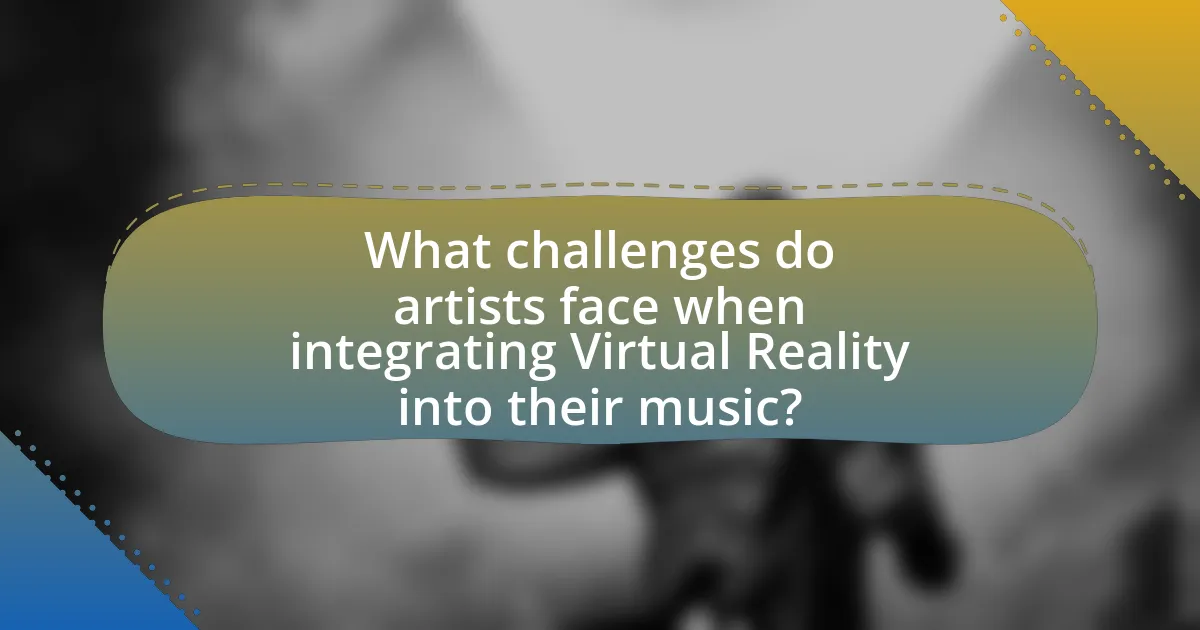
What challenges do artists face when integrating Virtual Reality into their music?
Artists face several challenges when integrating Virtual Reality into their music, primarily including high production costs, technical complexity, and audience accessibility. High production costs arise from the need for specialized equipment and software, which can be prohibitively expensive for many artists. Technical complexity involves mastering new tools and platforms, requiring significant time and effort to learn and implement effectively. Additionally, audience accessibility is a concern, as not all fans have access to VR technology, limiting the reach of VR music experiences. These challenges can hinder artists’ ability to fully realize their creative visions in the VR space.
How do technical limitations affect Virtual Reality music projects?
Technical limitations significantly hinder Virtual Reality music projects by restricting audio quality, spatial accuracy, and user interaction. For instance, low bandwidth can lead to latency issues, causing a disconnect between visual and auditory elements, which diminishes the immersive experience. Additionally, limited processing power in VR devices can restrict the complexity of soundscapes, resulting in less dynamic and engaging musical environments. Studies have shown that high-quality audio processing is essential for user engagement in VR, as poor audio can lead to user fatigue and disengagement. Thus, these technical constraints directly impact the effectiveness and appeal of Virtual Reality music experiences.
What are the common obstacles in creating VR music experiences?
Common obstacles in creating VR music experiences include high development costs, technical limitations, and user accessibility issues. High development costs arise from the need for specialized software and hardware, which can deter smaller artists and developers. Technical limitations, such as latency and the need for high-quality graphics, can hinder the immersive experience that VR aims to provide. Additionally, user accessibility issues, including the requirement for expensive VR headsets and the potential for motion sickness, can restrict audience engagement and participation in VR music experiences.
How can artists overcome these challenges?
Artists can overcome challenges in virtual reality and music by embracing collaboration with technology experts and utilizing accessible VR platforms. By partnering with developers, artists can create immersive experiences that enhance their musical performances. For instance, the use of platforms like Oculus Venues allows artists to reach wider audiences and engage fans in innovative ways. Additionally, artists can participate in workshops and training sessions to improve their technical skills, enabling them to navigate VR tools effectively. This approach not only expands their creative possibilities but also addresses the technical barriers often faced in integrating music with virtual reality.
What are the financial implications of using Virtual Reality in music?
The financial implications of using Virtual Reality in music include increased revenue streams through immersive experiences and higher production costs. Artists and music companies can generate income by offering virtual concerts, which have been shown to attract larger audiences; for example, Travis Scott’s virtual concert in Fortnite drew 12.3 million viewers, significantly boosting merchandise sales. However, the initial investment in VR technology and content creation can be substantial, with costs for high-quality VR production ranging from tens of thousands to millions of dollars. This duality of potential high returns against significant upfront costs defines the financial landscape of integrating Virtual Reality into the music industry.
How do production costs compare to traditional music formats?
Production costs for virtual reality music formats are generally lower than those for traditional music formats. Traditional music production often involves expenses related to studio time, physical distribution, and marketing, which can accumulate to tens of thousands of dollars. In contrast, virtual reality music experiences can be created with less physical infrastructure, utilizing software tools and digital distribution, which significantly reduces costs. For example, a study by the International Federation of the Phonographic Industry (IFPI) indicated that digital music production and distribution can cut costs by up to 50% compared to traditional methods. This shift allows artists to invest more in creative aspects rather than logistical expenses.
What potential revenue streams can artists explore with VR music?
Artists can explore several potential revenue streams with VR music, including virtual concerts, immersive experiences, and merchandise sales. Virtual concerts allow artists to reach global audiences without geographical limitations, often resulting in ticket sales that can exceed traditional concert revenues. Immersive experiences, such as interactive music videos or VR installations, can be monetized through subscriptions or one-time purchases, providing unique engagement opportunities for fans. Additionally, artists can sell exclusive VR content or merchandise within these virtual environments, further enhancing their revenue potential. The growing popularity of VR technology and its integration into the music industry supports these revenue streams, as evidenced by the success of platforms like Oculus Venues and Wave, which have hosted profitable virtual events.
What future trends can we expect in Virtual Reality and music?
Future trends in Virtual Reality and music include enhanced immersive experiences, increased interactivity, and the integration of artificial intelligence. Enhanced immersive experiences will allow users to engage with music in 360-degree environments, creating a sense of presence that traditional formats cannot achieve. Increased interactivity will enable users to manipulate soundscapes and visuals in real-time, fostering a more personalized experience. The integration of artificial intelligence will facilitate the creation of adaptive soundtracks that respond to user actions and preferences, as evidenced by projects like “AI Music” which explores AI-generated music tailored to individual tastes. These trends indicate a shift towards more engaging and personalized musical experiences in Virtual Reality.
How might advancements in technology shape the future of VR music experiences?
Advancements in technology will significantly enhance VR music experiences by improving immersion, interactivity, and accessibility. Enhanced graphics and audio technologies, such as spatial audio and high-resolution visuals, will create more realistic environments, allowing users to feel as if they are truly part of the performance. Additionally, developments in haptic feedback technology will enable users to physically feel the music, further deepening their engagement.
Moreover, artificial intelligence can personalize music experiences by analyzing user preferences and adapting performances in real-time, making each session unique. The integration of social features through improved connectivity will allow users to share experiences with others, fostering a sense of community.
For instance, a study by the International Journal of Human-Computer Interaction highlights that immersive audio-visual experiences can increase emotional engagement by up to 70%, demonstrating the potential impact of these technological advancements on VR music experiences.
What predictions can be made about audience engagement with VR music?
Predictions about audience engagement with VR music indicate a significant increase in immersive experiences, leading to deeper emotional connections and higher retention rates. As VR technology advances, studies show that users report heightened levels of presence and enjoyment, which can enhance their overall engagement with music. For instance, a report by the International Music Summit in 2021 highlighted that 70% of participants felt more connected to artists when experiencing music in a VR environment compared to traditional formats. This suggests that as VR becomes more accessible, audience engagement will likely grow, driven by the unique, interactive experiences it offers.
What best practices should artists follow when creating Virtual Reality music experiences?
Artists should prioritize immersive storytelling and interactivity when creating Virtual Reality music experiences. This approach enhances audience engagement by allowing users to explore the narrative and emotional depth of the music in a three-dimensional space. Additionally, artists should ensure high-quality audio and visual elements, as studies indicate that immersive experiences are significantly enhanced by superior sound design and graphics. For instance, a report by the International Journal of Human-Computer Interaction highlights that users rated experiences with high-quality audio as more engaging and memorable. Furthermore, artists should consider user comfort and accessibility, as prolonged VR sessions can lead to discomfort; thus, incorporating breaks and adjustable settings can improve user experience.
